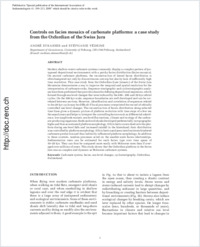Controls on facies mosaics of carbonate platforms : a case study from the Oxfordian of the Swiss Jura
- Strasser, André Department of Geosciences, University of Fribourg, Switzerland
- Védrine, Stéphanie Department of Geosciences, University of Fribourg, Switzerland
-
2009
Published in:
- Perspectives in Carbonate Geology: A Tribute to the Career of Robert Nathan Ginsburg. - 2009, p. 199–213
English
Modern shallow-water carbonate systems commonly display a complex pattern of juxtaposed depositional environments with a patchy facies distribution (facies mo saics). On ancient carbonate platforms, the reconstruction of lateral facies distribution is often hampered not only by discontinuous outcrop but also by lack of suffi ciently high time resolution. This case study from the Oxfordian (Late Jurassic) of the Swiss Jura Mountains demonstrates a way to improve the temporal and spatial resolution for the interpretation of carbonate rocks. Sequence-stratigraphic and cyclostratigraphic analyses have been performed that provide a basis for defi ning depositional sequences, which formed through sea-level changes that were induced by the 400-, 100- and 20-kyr orbital cycles. On the 100-kyr scale, sequence boundaries are well developed and can be correlated between sections. However, identifi cation and correlation of sequences related to the 20-kyr cycle may be diffi cult if local processes overprinted the record of orbitally controlled sea-level changes. The reconstruction of facies distribution along selected time lines gives a dynamic picture of platform evolution with time steps of a few ten thousand years and helps to interpret the controlling factors such as differential subsidence, low-amplitude eustatic sea-level fl uctuations, climate and ecology of the carbonate-producing organisms. Reefs and ooid shoals developed preferentially on topographic highs and thus accentuated platform morphology. Siliciclastics were shed onto the platform during sea-level falls and increased rainfall in the hinterland; their distribution was controlled by platform morphology. Siliciclastics and associated nutrients hindered carbonate production and thus indirectly infl uenced platform morphology. In addition to these controls, random processes acted on the smaller-scale facies relationships. Sedimentation rates can be estimated for each facies type over time spans of 10–20 kyr. They can thus be compared more easily with Holocene rates than if averaged over millions of years. This study shows that the Oxfordian platform in the Swiss Jura was as complex and dynamic as Holocene carbonate systems.
- Faculty
- Faculté des sciences et de médecine
- Department
- Département de Géosciences
- Language
-
- English
- Classification
- Palaeontology
- License
-
License undefined
- Identifiers
-
- RERO DOC 11827
- DOI 10.1002/9781444312065.ch13
- Persistent URL
- https://folia.unifr.ch/unifr/documents/301017
Statistics
Document views: 171
File downloads:
- pdf: 280
